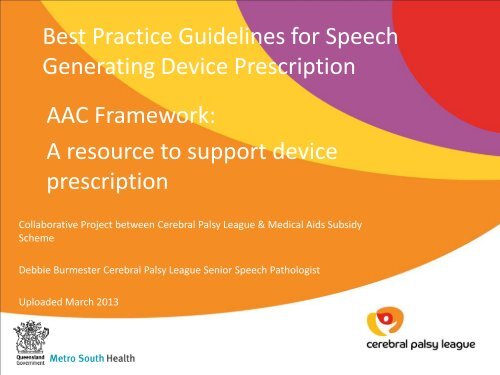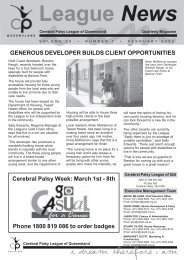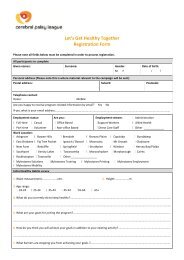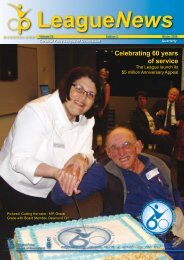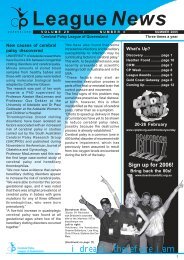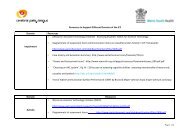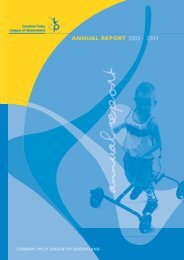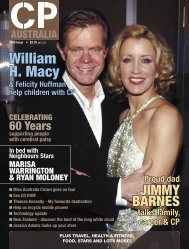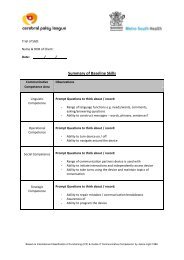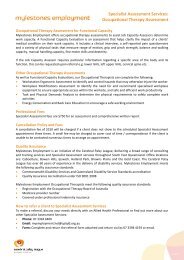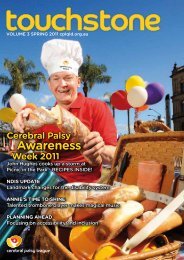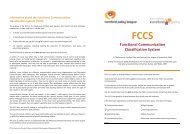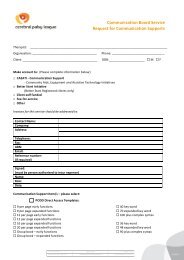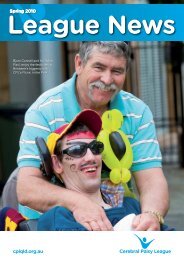AAC Framework: A resource to support device prescription
AAC Framework: A resource to support device prescription
AAC Framework: A resource to support device prescription
- No tags were found...
You also want an ePaper? Increase the reach of your titles
YUMPU automatically turns print PDFs into web optimized ePapers that Google loves.
Important InformationThis is a framework <strong>to</strong> <strong>support</strong> clinical decision makingand <strong>to</strong> encourage a team approach for <strong>prescription</strong>of Speech Generating Devices (SGD’s).It should be used alongside:- Processes and <strong>resource</strong>s that have been identifiedwithin your own organisation- Formal supervision and men<strong>to</strong>ring opportunitiesinternally and externally <strong>to</strong> your organisation-Next
How <strong>to</strong> ….?• This <strong>resource</strong> uses Powerpoint• It is divided in<strong>to</strong> four parts• Introduction• Stage 1 - Information Gathering• Stage 2 - Trial and Goal Setting• Stage 3 - Evaluation and Decision Making• Users can enter the <strong>resource</strong> at each of these key stages, or view in a stepby step fashion by following the “NEXT” but<strong>to</strong>ns• You must use the action but<strong>to</strong>n <strong>to</strong> navigate through, otherwise the orderwill be disrupted.• There are “jump off” but<strong>to</strong>ns <strong>to</strong> and from documents with moreinformation. Either use BACK or close the open document that hasbeen hyperlinked.Next
Where <strong>to</strong> start?• Introduction, ICF <strong>Framework</strong>, Case Studyintroductions (next)• Assessment & Information Gathering• Trials and goal setting• Evaluation and Decision Making
The ICF <strong>Framework</strong>A holistic, biopsychosocial modelMore detailsNext
ICF InformationRecommended Reading• The World Health Organization’s International Classification of Functioning,Disability and Health: Implications for Clinical and Research Practice in the field ofAugmentative and Alternative Communication, P Rhagavendra, J Bornman, MGranlund and E Bjork-Akersson, Augmentative and Alternative Communication,December 2007• Towards an international framework for communication disorders: Use of the ICF,Travis T Threats, Journal of Communication Disorders, 2006• Making a World of Difference: The ICF-CY as a Tool for Building GlobalCommunities of <strong>AAC</strong> Providers, Sharon M. Rogers, IS<strong>AAC</strong>, Barcelona, Spain, July 27,2010. Retrieved from http://drsharonrogers.typepad.com/files/isaac-2010-makinga-world-of-difference-final-1.pptAdditional Reading• WHO International Classification of Functioning, Disability and Health• Information, training and <strong>resource</strong>s. Retrieved fromhttp://www.who.int/classifications/icf/en/BackNext
ICF InformationAdditional Reading (cont’d)• Advances in Speech pathology, Volume 6, march 2004• Classifying communication disability using the ICF, T.T.Threats & L. Worrall• Where is the person in the ICF? J. Felson Duchan• Cautiously embracing the ICF, N. Simmons-Mackie• The ICF language of numeric adjectives, L. Boles• Speech pathologists’ application of the ICF <strong>to</strong> children with speechimpairment, S. McLeod• The ICF is all about the person, and more: A response <strong>to</strong> Duchan, Simmons-Mackie, Boles and McLeod• ICF: A guide <strong>to</strong> Assistive Technology Decision-making, Petra Karlsson. Retrievedfromhttp://www.arata.org.au/arataconf10/papers/KARLSSON_Petra_paper_arata10.doc• Framing <strong>AAC</strong> IEP Goals with ICF• http://mcn.educ.psu.edu/documents/Fried-Oken_Rowland_Lollar_Steiner_Framing_<strong>AAC</strong>_IEP_Goals_with_ICF_ASHA_2010.pdfNextBack
How will this framework help me and where do Istart?Prescription of a <strong>device</strong> is a very involvedprocess and can be quite a journey.Assessment &InformationGatheringIdentify trialoptions & setgoalsEvaluation /DecisionMakingNext
AlertThe purpose of using the ICF framework is<strong>to</strong> provide a ‘holistic’ and multifaceted view<strong>to</strong> gather all information <strong>to</strong> <strong>support</strong> SGD<strong>prescription</strong>. This means that all elementsof the ICF are relevant and need <strong>to</strong> beconsidered and integratedBe sure <strong>to</strong> check out all components of the ICFNext
Guidelines for Considering Speech Generating Device (SGD) Options Based on the ICF(www.who.int)Health ConditionImpairment- Mentalfunctions/cognition- Diagnosis & Prognosis- Sensory (vision &hearing)-Neuromusculoskeletal(access)Activity- Communication- InterpersonalInteractions &relationships- Learning & applyingknowledge- Mobility (for portabilityof <strong>device</strong>)Participation- Home- Education- Community life- EmploymentEnvironment- Products & Technology- Best match, <strong>support</strong> & training- Attitude of family & othersPersonal Fac<strong>to</strong>rs- Motivation- Attitude- Past experience and effectNext
Lifestages• It is important <strong>to</strong> look at what is happening for the client now,as well as their future needs.• Increased understanding of lifestages assists us <strong>to</strong> identifycommunication partners, communication functions, and theenvironments where communication is required for theindividual• Having an understanding of needs for now and later will helpyou <strong>to</strong> set realistic functional goals for meaningful outcomes• There a some <strong>resource</strong>s that you can use <strong>to</strong> <strong>support</strong>exploration of life-stagesMore detailsNext
Timetable for Growing Up“ Young people and their families go through many changes asthey grow up. The Growing Up Ready <strong>resource</strong>s are designed<strong>to</strong> help children and youth with disabilities <strong>to</strong> get ready foradult life.”www.hollandbloorview.ca/<strong>resource</strong>centre/growing_up/documents/timetable.pdfParentingSocialSelf-CareEducationMedicalBack
Prescription Process3 key stages:• Assessment and information gathering• Trials & goal setting• Evaluation & decision makingAssessment &InformationGatheringIdentify trialoptions & setgoalsEvaluation /DecisionMakingNext
Guidelines for Considering Speech Generating Device (SGD) Options Based on the ICF (www.who.int)MarshaHealth ConditionOliverTaraImpairment- Mentalfunctions/cognition- Diagnosis & Prognosis- Sensory (vision &hearing)-Neuromusculoskeletal(access)Activity- Communication *- InterpersonalInteractions &relationships- Learning & applyingknowledge- Mobility (for portabilityof <strong>device</strong>)Participation- Home- Education- Community life- EmploymentJoEnvironmentProducts & Technology– Best match, <strong>support</strong> & training-Attitude of family & othersPersonal Fac<strong>to</strong>rsMotivationAttitudePast experience and effectCASE STUDIES – To be used asExamples ONLYNext
Marsha: a brief overview• Marsha • is 49 is 49 yrs yrs and and has has a diagnosis a of ofMND MND• Her • Her speech is becoming is dysarthric• She • She is keen is keen <strong>to</strong> <strong>to</strong> explore <strong>AAC</strong> <strong>AAC</strong> <strong>to</strong> <strong>to</strong> maintaincurrent levels of of communicationBack
.Tara : a brief overview• Tara is 5 yrs and has significantdevelopmental delays• It is a challenge <strong>to</strong> engage Tara, although sheresponds well <strong>to</strong> physical activity, by smilingBack
Oliver : a brief overview• Oliver is 12 yrs and has a diagnosis of ASD• He is a reluctant PECS user andcommunicates mainly using informalmethods• He will be transitioning <strong>to</strong> a new specialneeds unit at the end of the yearBack
Jo : a brief overview• Jo is 17 yrs and has cerebral palsy• His <strong>device</strong> needs replacing• He will be leaving school at the end of theyearBack
Stage 1: Assessment and Information GatheringAssessment &InformationGatheringIdentify trialoptions & setgoalsEvaluation /DecisionMakingBack <strong>to</strong> startNext
Principles <strong>to</strong> consider <strong>to</strong> <strong>support</strong> assessment:• Participation model• Dynamic assessment & Feature Matching• Team and collaboration• Natural settings• Training, men<strong>to</strong>ring, & <strong>support</strong>• Evidence based ethical practiceReferenced in Speech Pathology Australia, ‘Augmentative & AlternativeCommunication’ Clinical Guidelines, 2012Next
Assessment and information gathering• Consider all components of ICF framework• Impairment• Activity• Participation• Environment• Personal Fac<strong>to</strong>rsThe following ‘Prompt Questions’ will help you gatherinformation across all areas of the ICF: Domain Questions.pdfWho can help?Next
Who else can assist in the assessment process?Remember, as we are using the ICF framework and wanting aholistic view of the individual, we can gather information frommany professionals including:•Medical specialists•Family and other significant people in the person’s life•Teachers, teacher aides, and <strong>support</strong> workers•Allied Health Professionals – Occupational Therapist,Physiotherapist, Speech Pathologist, Social Worker•Assistive Technology assessment services (internal and /orexternal <strong>to</strong> organisation)•SuppliersNext
Impairment• Overall assessment of body structure andfunction, including cognitive function• Multidisciplinary• Consider diagnosis and prognosisNext
ImpairmentCognitiveSkillsSensorySkillsPhysicalStatusNext
Impairment: What do you need <strong>to</strong> know?• What is the person’s overall physical status?• What is the persons level of cognition and ability <strong>to</strong> learn?• Do they have an understanding of cause and effect?• Do they have an understanding of symbols – that one item can representanother?• If they understand symbols, what sort – objects, pho<strong>to</strong>s, line drawings,picture symbols, words/letters?• Memory capacity• Rate of learning?• Does the person have impairments in their vision or hearing?• What does their diagnosis tell you about the future?• Skills likely <strong>to</strong> develop further? Where <strong>to</strong>? - in short, medium and long term?• Skills likely <strong>to</strong> deteriorate?• Likely speed of change?Information gathering:• Become familiar with diagnosis and typical presentations.• Be aware of likely prognosisNext
How do we gather information regarding‘impairment’?• Access <strong>to</strong> medical records and allied healthreports• Comprehensive case his<strong>to</strong>ry information• Use of checklists / <strong>resource</strong>s as identified• Accessing further information from crediblesources e.g. Medical websites regarding‘diagnosis’ and ‘prognostic’ information.Next
Resources – ImpairmentRefer <strong>to</strong> Resource List:Resources for ICF Domains.pdfNext
Activity• Impact of physical, cognitive and/or sensoryimpairments on daily functioning• How does the person move their body <strong>to</strong> performactivities of daily living?• How do they use their vision and hearing?• What is their understanding of the world and howdo they interact with it e.g. behaviour,communication?Next
Activity: What do you need <strong>to</strong> know?• What is the person’s level of language and communication skills?• Pre-intentional, intentional• Emergent, context dependent, independent• What is their level of receptive language?• What sort of <strong>device</strong> will meet their needs – single message, sequencedmessage, multiple message (static display), multiple message (dynamicdisplay), text <strong>to</strong> speech• How will language be represented? Single meaning pictures (e.g. Gateway),multiple meaning pictures (e.g. Unity), words and letters• If using single meaning pictures, symbol set will be used e.g. PictureCommunication Symbols (PCS), Symbolstix etc• How will language be organised? Topic based, pragmatically, grammatically?• How will the person activate a <strong>device</strong> and mobilise within their environment?• Direct; direct with minor modifications (e.g.keyguard); direct with sophisticatedaccessories (e.g. headpointing, eye gaze); indirect etc• Will the <strong>device</strong> be carried or mounted?Next
Activity: What do you need <strong>to</strong> know?(contd)• How do any sensory impairments (e.g. Vision and hearing) impact onfunctioning?• Can the person see and discriminate between visual symbols? How many?• Do they need symbols <strong>to</strong> be enlarged? Do they need tactile symbols? Do theyneed audi<strong>to</strong>ry feedback?• How does the person’s cognitive status (as per prompt questions in Impairment)impact on the persons interaction and communication skills?• Do they have an understanding of symbols – that one item can representanother?• If they understand symbols, what sort – objects, pho<strong>to</strong>s, line drawings, picturesymbols, words/letters?• Information gathering• Work with colleagues <strong>to</strong> assess relevant physical, cognitive and sensory skills• Assess person’s language and communication skillsNext
SGD AccessAccess must be considered before investigatingSGD options.• Does the individual have an existing SGD and accessmethod?• Is the current access method reliable or does it requirereview by an Occupational Therapist?• If the individual is not using a SGD, can an accessmethod be identified from their upper limb functionor use of other technologies. This may require areview by an Occupational Therapist.Click here <strong>to</strong> find out more about - SGD AccessOptions.pdfNext
Impairment & Activity Fac<strong>to</strong>rsDevice suitable <strong>to</strong> meetcognitive, language andcommunication needs <strong>to</strong>dayand in future.Features <strong>to</strong> meet vision andhearing needs.Access method andtransportation – which maychange as skills develop ordeteriorateNext
Gathering Activity Information• Multidisciplinary• Access skills• Language and communication skillsSpecific Assessment Examples (Next)• Resources: Resources for OCF Domains.pdfBest Practise Guidelines require the involvement of amultidisciplinary team including SLP’s, OT’s, PT’s and others,as relevantNext
Assessing language and communication skills• Young child• Child• Teen• Young adult• AdultNext
Young Child – Communication AssessmentsEmergentContextdependentIndependentCommunicationMatrixPragmatic ProfileInven<strong>to</strong>ry of PotentialCommunication Acts(IPCA)StandardisedAssessments e.g. PreVerbal CommunicationAssessment , Rosetti,REEL, McArthur ScalesStandardisedAssessments e.g. PLS,CELF-Preschool,BackAssessment details
Child – Communication AssessmentsEmergentContextdependentIndependentCommunicationMatrixPragmatic ProfileInven<strong>to</strong>ry of PotentialCommunication Acts(IPCA)Standardised Assessmentse.g. Pre VerbalCommunicationAssessment ,Standardised Assessmentse.g. PLS, CELF, CASLBackAssessment details
Teen – Communication AssessmentsEmergentContextdependentIndependentPragmatic ProfileInven<strong>to</strong>ry of PotentialCommunication Acts(IPCA)Standardised Assessmentse.g. Pre VerbalCommunicationAssessment ,Standardised Assessmentse.g. CELF, CASLBackAssessment details
Young Adult – Communication AssessmentsEmergentContextdependentIndependentPragmatic profileStandardAssessments e.g.Triple C ChecklistStandardAssessments e.g.CELFStandardAssessments e.g.BackAssessment details
Adult – Communication AssessmentsEmergentContextdependentIndependentPragmatic ProfileStandard Assessmentse.g. Triple C ChecklistStandard Assessmentse.g.BDAE, PALPA, WAB,Frenchay DysarthriaAssessmentBackAssessment details
Assessment detailsThis is a list of commonly used assessments and it is acknowledged that otheroptions exist. We encourage you <strong>to</strong> review details and application of assessmentsthat are unfamiliar <strong>to</strong> you. Links are provided for ‘known’ online <strong>resource</strong>s.Refer <strong>to</strong> Resource List:Resources for ICF Domains.pdfBack <strong>to</strong>:Young ChildChildTeenYoung AdultAdultNext
Participation• How the person uses their skills and abilities <strong>to</strong> participatein life - at home, school, work• What does the person do or need <strong>to</strong> do, <strong>to</strong> participate <strong>to</strong>the best of their ability in these environments?• What are the facilita<strong>to</strong>rs and barriers <strong>to</strong> participation?Next
Participation: What do you need <strong>to</strong> know?• What activities is the person engaged in? Daily, regularly, occasionally?• What will the person want or need <strong>to</strong> communicate in these differentsituations?• Will the <strong>device</strong> have the language/vocabulary <strong>to</strong> meet these needs?• Can the <strong>device</strong> expand <strong>to</strong> meet new and changing needs?• Will the <strong>device</strong> be practical in all settings? e.g. size, weight, durability,volume of speech output• Can it be easily moved, mounted?Information gathering:• Talk <strong>to</strong> person, their family, teachers, <strong>support</strong> workers, carers etc, <strong>to</strong> ensurethe <strong>device</strong> will have the features, settings and vocabulary <strong>to</strong> allow theperson <strong>to</strong> communicate <strong>to</strong> their maximum potential• Discuss and problem solve any practical issuesNext
Adding Participation Fac<strong>to</strong>rs <strong>to</strong> the Mix…Participation fac<strong>to</strong>rsDevice that hasthe capacity <strong>to</strong>meet needs in avariety ofsituations andwith a variety ofpeopleImpairment & activity fac<strong>to</strong>rsDevice that theperson can useefficiently andeffectively, withthe mostappropriate meansof representinglanguageNext
Participation <strong>resource</strong>sRefer <strong>to</strong> Resource List:Resources for ICF Domains.pdfNext
Environment•What aspects of the person’s environmentfacilitate activity and participation?•What aspects of a person’s environment arebarriers <strong>to</strong> activity and participation?Next
Environment: What you need <strong>to</strong> know• Who is in the persons’ circle of <strong>support</strong>?• Who will ensure the person using the <strong>device</strong> is given every opportunity <strong>to</strong> participate?• Who will teach the person <strong>to</strong> use their <strong>device</strong> <strong>to</strong> their maximum potential?• Who will add vocabulary and keep the <strong>device</strong> relevant <strong>to</strong> the persons needs?• Who will <strong>support</strong> <strong>device</strong> use in terms of the following:• Charging batteries?• Set up of any additional accessing equipment?• Troubleshooting operational issues?• Back up of individual programming and general maintenance?• Will there be major changes in the person’s situation? Transition <strong>to</strong> school, high school, TAFE,work etc? Who will facilitate this transition in terms of <strong>device</strong> <strong>support</strong>?• Will it integrate with other technologies?• Will there be financial issues?Information gathering:• Ensure <strong>support</strong> team is willing and prepared <strong>to</strong> <strong>support</strong> the implementation of a <strong>device</strong>• Discuss training needs, as necessary• Discuss practical issues of integration of technology, <strong>support</strong> and maintenance <strong>to</strong> determinefacilita<strong>to</strong>rs and barriers• Identification of key stakeholders if transition is imminent• Exploration of funding optionsNext
Adding Environment Fac<strong>to</strong>rs <strong>to</strong> the Mix ...Environmentfac<strong>to</strong>rsDevice that is accepted,practical, <strong>support</strong>able andaffordable in theenvironmentParticipationfac<strong>to</strong>rsDevice that has thecapacity <strong>to</strong> meet needsin a variety ofsituations and with avariety of peopleImpairment &Activity fac<strong>to</strong>rsDevice that the personcan use efficiently andeffectively, with themost appropriatemeans of representinglanguageNext
Refer <strong>to</strong> Resource List:Environment <strong>resource</strong>sResources for ICF Domains.pdfNext
Personal Fac<strong>to</strong>rs• Fac<strong>to</strong>rs related <strong>to</strong> personality, preferences,past experiences etc• The things that make us unique and individualNext
Personal Fac<strong>to</strong>rs: What you need <strong>to</strong> know• How well do you know the person?• What is the persons level of motivation <strong>to</strong> learn/use a <strong>device</strong>?• What are their previous experiences with an <strong>AAC</strong> system/<strong>device</strong>?• What are their preferences in terms of <strong>device</strong> type, aesthetics etcInformation gathering:• Talk <strong>to</strong> the person, their family and close <strong>support</strong> team• Involve them in the decision making process• Always try <strong>to</strong> offer an opportunity for informed choice• Take their thoughts and preferences seriously and try <strong>to</strong> accommodatewherever possibleNext
Adding Personal Fac<strong>to</strong>rs <strong>to</strong> the Mix ...Environmentfac<strong>to</strong>rsDevice that is accepted,practical and <strong>support</strong>able inthe environmentPersonal fac<strong>to</strong>rsDevice that ispreferred by thepersonParticipationfac<strong>to</strong>rsImpairment &Activity fac<strong>to</strong>rsDevice that theperson can useefficiently andeffectively, withthe mostappropriatemeans ofrepresentinglanguageDevice that has the languagecapacity <strong>to</strong> meet needs in avariety of situations and with avariety of peopleNext
Personal fac<strong>to</strong>rs <strong>resource</strong>sRefer <strong>to</strong> Resource List:Resources for ICF Domains.pdfNext
Four Case StudiesAssessment and Information GatheringMarshaTaraOliverJoForward <strong>to</strong> Stage 2: Trial Options and Goal Setting
Health ConditionMo<strong>to</strong>r Neurone Disease(progressive)Marsha, 49 yrsImpairmentAmyotrophic lateral sclerosisWeakness / atrophy in legs,arms and oral mo<strong>to</strong>rmusculatureNo evidence of cognitivedeclineActivityMobilises in wheelchairADL’s slow and fatiguingSpeech becoming dysarthric –speech slurred, shallowbreathingRegular coughing whilst eatingand drinkingParticipationLives aloneModified work dutiesAttends church with assistanceBecoming less socially activePersonal Fac<strong>to</strong>rsFiercely independentTechnology savvyEnvironmentAware of communicationtechnologyMay not be eligible for fundingOver-protective parents(elderly)Back <strong>to</strong> Case StudiesAssessment
Assessment and Information Gathering• Refer back <strong>to</strong> Key Stage 1• Gather information in all domains of ICF• Involve the client, their family and key <strong>support</strong>people in their network• Involve professional colleaguesNext
Let’s Look at Marsha through ICF eyes .....The ICF Prompt Questions have been applied <strong>to</strong>Marsha, <strong>to</strong> provide more information <strong>to</strong> <strong>support</strong>your assessment and information gathering. Clickhere <strong>to</strong> understand more about Impairment,Activity, Participation, Environment, & PersonalFac<strong>to</strong>rs ICF Domain Questions Marsha.pdfNext
ImpairmentDevice with alternativeaccess options shouldthese become necessaryContemporary designwith access <strong>to</strong> socialmediaPersonalFac<strong>to</strong>rsMarshaActivityText <strong>to</strong> speech +rate enhancementAble <strong>to</strong> be <strong>support</strong>ed byfriends and family ifMarsha becomes unable<strong>to</strong> do soEnvironmentParticipationKeyboard v<strong>to</strong>uchscreen? -unknownAffordable (if funding notavailable)Easily moved andrepositionedWhich <strong>device</strong>? Potential candidates for trial:Lightwriter SL40, Dynawrite, iPad with Predictable, Smart II, Nova Chat 7/11?Back <strong>to</strong> case studies
Health ConditionDevelopmental DelayTara, 5 yrsImpairmentLearning difficultiesSensory and attentionchallengesDecreased oral mo<strong>to</strong>rdifficulties - ++ saliva lossActivityMobilises by crawling and can pull selfup on furnitureWill reach for desired play objectssymbolic play developingVocalises and some simple gesturesduring interactionsParticipationEnrolled for mainstream prep nextyearCurrently attend Kindy 5 days/wkGoes <strong>to</strong> a play gym with youngersiblingEnvironmentSingle Mum who is ++ busyOnly child with complexcommunication needs in kindy(has teacher aide <strong>support</strong>)Personal Fac<strong>to</strong>rsVery active childLikes exploring her ownenvironment and engaging innew thingsNext
Assessment and Information Gathering• Refer back <strong>to</strong> Key Stage 1• Gather information in all domains of ICF• Involve the client, their family and key <strong>support</strong>people in their network• Involve professional colleaguesNext
Let’s Look at Tara through ICF eyes .....The ICF Prompt Questions have been applied <strong>to</strong>Tara, <strong>to</strong> provide more information <strong>to</strong> <strong>support</strong> yourassessment and information gathering. Click here<strong>to</strong> understand more about Impairment, Activity,Participation, Environment, & Personal Fac<strong>to</strong>rs ICFDomain Questions Tara.pdfNext
Support for Mum <strong>to</strong>satisfy her that simple,static <strong>device</strong>s are themost appropriate, at thisstageCapable of being used insituations that motivate Tarae.g playgroundactivities/environmentInvestigate staff <strong>support</strong>needs in current andfuture placementsPersonalFac<strong>to</strong>rsConsider implications ofproducing/providing symbolrepresentations e.g. objects ofreference, symbol producing programs(i.e. Boardmaker)EnvironmentImpairmentTaraLarge target area initially <strong>to</strong>accommodate gross mo<strong>to</strong>rskillsParticipationActivityWhich <strong>device</strong>? Potential candidates for trial:Big Mack, 4 Compartment Communica<strong>to</strong>r,Cheap Talk 8 with switch jacks, TechTalk, SupertalkerBack <strong>to</strong> case studiesFlexibility ofsymbolrepresentation –3D, 2DConsolidation ofcause/effectunderstanding (1 message)with capacity <strong>to</strong> increaseas skills developEasily moved andrepositioned <strong>to</strong>accommodate behaviour
Oliver, 12yrsHealth ConditionAutism Spectrum DisorderImpairmentSome fine mo<strong>to</strong>r planningdifficultiesCognitive delaysVisual-perceptual difficultiesActivityIndependently mobileHas some understanding of picturesymbols (PCS) <strong>to</strong> represent languageAppears <strong>to</strong> learn best in structured,naturalistic settings and within ownareas of interestParticipationRequires special educationalprogramParticipation dependent onothers <strong>to</strong> engage him in activityPredominance of requestingand directingbehaviour/communicationEnvironmentLives with parents and 2 siblings, 1 with ASDalsoBoth parents unemployedLittle extended family <strong>support</strong>Personal Fac<strong>to</strong>rsVery interested in all kinds of transport – cars,trucks, trains etcNeeds large personal space separationParticularly attached <strong>to</strong> younger sister (withoutdisability)Next
Assessment and Information Gathering• Refer back <strong>to</strong> Key Stage 1• Gather information in all domains of ICF• Involve the client, their family and key <strong>support</strong>people in their network• Involve professional colleaguesNext
Let’s Look at Oliver through ICF eyes .....The ICF Prompt Questions have been applied <strong>to</strong>Oliver, <strong>to</strong> provide more information <strong>to</strong> <strong>support</strong>your assessment and information gathering. Clickhere <strong>to</strong> understand more about Impairment,Activity, Participation, Environment, & PersonalFac<strong>to</strong>rs ICF Domain Questions Oliver.pdfNext
Has not been motivated byindividual symbol cards(static) used in PECS programSuccess will be highlydependent on finding a<strong>device</strong> that motivates OliverSupport for family who may havelimited capacity <strong>to</strong> implement<strong>device</strong>. Focus on sister?Implementation of <strong>device</strong> mayassist <strong>to</strong> change staff attitudes <strong>to</strong>Oliver's potential. Need <strong>to</strong>investigate <strong>support</strong> needs incurrent and future placementsConsider implications of producingsymbol representations if staticdisplay <strong>device</strong> chosen e.g.BoardmakerPersonalFac<strong>to</strong>rsEnvironmentImpairmentOliverParticipationDisplay appearance (static v dynamic)and cell size yet <strong>to</strong> be determined andneeds <strong>to</strong> meet both physical and visualperceptual needsActivityWhich <strong>device</strong>? Potential candidates for trial:SmartSpeak, Tobii S32, Dynavox M3, Nova Chat 7/11?Back <strong>to</strong> case studiesStatic v dynamic style yet <strong>to</strong>be determined – need <strong>to</strong>balance learning needs,language andcommunication needs andpossible preference fordynamic displayLearning activities need <strong>to</strong> behighly structured + motivating <strong>to</strong>ensure understanding andmeaningful use of <strong>device</strong>Must be easilytransportable for OliverMust be robust <strong>to</strong> withstandheavy handling
Jo, 17 yrsHealth ConditionCerebral Palsy (SpasticQuadriplegia)ImpairmentCP affecting all 4 limbs (stiff /tightness)Increased stiffness / changes inhead movements recentlyHealth deteriorating – chestinfectionsActivityMobilises independently in poweredmobilityProficient communica<strong>to</strong>r currently usingPathfinder SGD (head access with switchand scanning)ParticipationCurrently lives with parents and 1siblingRelationships with wide range ofpeopleAttends mainstream high school with<strong>support</strong>Planning <strong>to</strong> go <strong>to</strong> TAFE for furthereducationEnvironmentPlanning <strong>to</strong> move out of homePersonal Fac<strong>to</strong>rsHaving access <strong>to</strong> ‘new’ technology isimportantDetermination for independenceNext
Assessment and Information Gathering• Refer back <strong>to</strong> Key Stage 1• Gather information in all domains of ICF• Involve the client, their family and key <strong>support</strong>people in their network• Involve professional colleaguesNext
Let’s Look at Jo through ICF eyes .....The ICF Prompt Questions have been applied <strong>to</strong>Jo, <strong>to</strong> provide more information <strong>to</strong> <strong>support</strong> yourassessment and information gathering. Click here<strong>to</strong> understand more about Impairment, Activity,Participation, Environment, & Personal Fac<strong>to</strong>rs ICFDomain Questions Jo.pdfNext
Which <strong>device</strong>? Potential candidates for trial:Eco2, Vantage Lite or Accent? (after othernon-unity <strong>device</strong> options explored with Jo)ImpairmentDevices with multiple accessoptions <strong>to</strong> explore alternatives<strong>to</strong> head mounted switchAbility for youngerpeople in Jo’s circleof <strong>support</strong> <strong>to</strong> engagemore readily and ageappropriatelyPersonalFac<strong>to</strong>rsJoActivityUnity based <strong>device</strong><strong>to</strong> retain priorlearning andgenerative system –Jo’s preferenceCost – can fundingbe obtained?Transition <strong>to</strong> TAFE.Establish training needsEnvironmentParticipationUnity <strong>device</strong> that ismore mainstreamand can integratewith othertechnologyMounting options mayneed <strong>to</strong> be considered ifaccess method changesBack <strong>to</strong> case studiesNext (stage 2 )
Stage 2 : Trial Options & Goal SettingAssessment&InformationGatheringIdentify trialoptions &set goalsEvaluation /DecisionMakingBack <strong>to</strong> startNext
Trials & GoalsThere are many options out there <strong>to</strong> trial withclients. The best trials will be using theinformation you have gathered in the first stepusing the ICF framework and thinking aboutthe current and future life stages for theperson. Remember, we want <strong>to</strong> findsomething that will <strong>support</strong> the client for atleast 5 years.Next
The Trial CycleDuring the trial, we want <strong>to</strong> see outcomes in as many areas as possible acrossthe ICF. You can think of this as a cycle, ticking off the areas as you trial the<strong>device</strong>. A successful trial will have most if not all categories ticked.ImpairmentPersonalFac<strong>to</strong>rsActivityEnvironmentParticipationNext
.The Trial ProcessThe following Trials will take time and should bebased on functional goals that you want <strong>to</strong>achieve during the trialeps can be followed:1. Determine 2-3 options of SGD’s2. Trial each option with the client (minimum of2 weeks), establishing baseline skills andgoals <strong>to</strong> be achieved during the trialNext
Options <strong>to</strong> TrialChoose SGD’s that appear <strong>to</strong> be the ‘Best-Fit’ according <strong>to</strong> theinformation you have gathered for the client. You will need <strong>to</strong>trial each option <strong>to</strong> determine the ‘actual’ fit and gatherinformation from the client and significant others.Remember, you are aiming for something that:• Allows the person <strong>to</strong> communicate a range of communicationfunctions• Can be used with familiar and unfamiliar communicationpartners• Can be used and <strong>support</strong>ed across different environmentsSGD Options Prompt Questions.pdfNext
Go <strong>to</strong> points for different Speech GeneratingDevices:The following SGD distribu<strong>to</strong>rs have interactive websites whereyou can search for SGD options <strong>to</strong> see and gather moreinformation:• Spectronics - www.spectronicsinoz.com• Zyteq - www.zyteq.com.au• Libera<strong>to</strong>r – www.libera<strong>to</strong>r.net.au• Link AT – www.linkassistive.com• CommunicATe – www.communicateat.com.au(NB. This is not an entire list and therapists are encouraged <strong>to</strong>source all options)Next
The TrialDuring each trial, it can be useful <strong>to</strong>:1. Determine baseline skills for using the <strong>device</strong>2. Establish goals <strong>to</strong> be achieved3. Measure outcomes from the goals setNext
Determining Baseline SkillsYou will need <strong>to</strong> have a good understanding ofthe person’s initial abilities and skills with the<strong>device</strong>, and how this fits in with theirenvironment. The following template may<strong>support</strong> gathering of this information, basedon Janice Light’s model of ‘CommunicativeCompetence’ (1989):Device Trial Baseline Proforma.pdfNext
Goal Setting – General Principles• Client and family focused• Focus on functional outcomes in Activity andParticipation domains of ICF, with considerationof other ICF components• Consider Activities and Participation in multipleenvironments.• Information gathered from the ‘BaselineProforma’ may assist <strong>to</strong> develop specific shortterm goals during the trialNext
What is a Goal?A goal should be a simple statement that outlines the desiredoutcome <strong>to</strong> be achieved:Condition Action How measured?Child example:When given a Vmax<strong>device</strong>Adult example:With a LightwriterTom will greet hispeersBob will request hismorning tea at a localcafeEvery morning duringcircle time at schoolAt least once a weekReference: ‘PRC Transitioning Toolkit’Next
Resources <strong>to</strong> Support Goal Setting• Special Education Technology (SET) – BritishColumbia at www.setbc.org (based oncommunicative competence and different levels ofdependence / independence• Rocky Bay ‘Information Kit for <strong>AAC</strong> Teams’ –www.rockybay.org.au /go/services/clinical-servicesdirec<strong>to</strong>rate/<strong>resource</strong>s/information-kit-for-aac-teams• SETT <strong>Framework</strong> by Joy Zabala atwww.joyzabala.comNext
Measuring Outcomes from the Goals SetThe following <strong>to</strong>ols are useful <strong>to</strong> formaliseoutcomes of the goals set for trial:• Goal Attainment Scale (GAS) (Kiresuk &Sherman, 1968)• Canadian Occupation Performance Measure(COPM)• Qualitative Information about when the<strong>device</strong> was used, who with, and what for (youcan keep this documentation during the trial).Next
Four Case StudiesTrial Options and Goal settingMarshaTaraOliverJoBack <strong>to</strong> trial options and goal settingForward <strong>to</strong> Evaluation and decision making
ScoreBaseline(skill level at start oftrial)-2Less than expectedoutcome-1Expected outcome0Example Goal for Marsha - 1Attainment Level / OutcomeUsing a text <strong>to</strong> speech <strong>device</strong>, Marsha constructs a full message withregular spelling errors, slow speed ( >6 mins) and some effort.Using a text <strong>to</strong> speech <strong>device</strong>, Marsha will construct a full message withregular spelling errors, slow speed (>4 – 6 mins) and some effort.Using a text <strong>to</strong> speech <strong>device</strong>, Marsha will construct a full message withregular spelling errors, regular speed (>2 - 4 mins) without effort.Greater thanexpected outcome+1Much greater thanexpected outcome+2Using a text <strong>to</strong> speech <strong>device</strong>, Marsha will construct a full message withminimal spelling errors, adequate speed (>0 - 2 mins) without effort.Using a text <strong>to</strong> speech <strong>device</strong>, Marsha will construct a full message with nospelling errors, adequate speed (>0 - 2 mins) without effort.Next
ScoreBaseline(skill level atstart of trial)-2Less thanexpectedoutcome-1Expectedoutcome0Example Goal for Marsha - 2Attainment Level / OutcomeMarsha does not have access <strong>to</strong> a Speech Generating Device which integratescommunication and social media functions in a sleek design.Marsha does have access <strong>to</strong> a Speech Generating Device, however there is notintegration of communication and social media functions within a sleek design.Marsha has access <strong>to</strong> a Speech Generating Device which integratescommunication and social media functions in a sleek design, and she issome what happy with the choice.Greater thanexpectedoutcome+1Much greaterthan expectedoutcome+2Marsha has access <strong>to</strong> a Speech Generating Device which integratescommunication and social media functions in a sleek design, and she ismoderately happy with the choice.Marsha has access <strong>to</strong> a Speech Generating Device which integratescommunication and social media functions in a sleek design, and she is ecstaticwith the choice.Next
Trial InformationLightwriterSL40DynawriteiPad with text<strong>to</strong> speechiAppSmart IINovaChat7 or 10ALL: Spelling keyboards, displays, rate enhancement features e.g. word prediction,portable+ve•Simple,intuitive•Keyboardcapitalises ontyping skills•Keyguardsavailable+ve• Simple,intuitive•Keyboardcapitalises ontyping skills•Keyguardsavailable•Switch andscanning+ve•Sleek,mainstreamdesign•Access <strong>to</strong> emailand social media•Switch accessmay be availablewith additionalinterface (iAppspecific)+ve•Very smalland portable•Switch andscanning+ve•Sleek, mainstreamdesign•Access <strong>to</strong> email andsocial media•Switch and scanning-ve•No alternativeaccess options•No access <strong>to</strong>email, socialmedia-ve•No access <strong>to</strong>email, socialmedia-ve•Volume – mayneed additionalspeakers - ? easeof portability•Access does notmake use oftyping skills-ve•Access doesnot make useof typingskills•No keyguards•No access <strong>to</strong>email, socialmedia-ve•Access does not makeuse of typing skillsBack
Example Goal for Tara - 1ScoreBaseline(skill level at start oftrial)-2Less than expectedoutcome-1Expected outcome0Attainment Level / OutcomeGiven a static simple communication <strong>device</strong>, Tara will lift up her sipper cup and shake it <strong>to</strong>indicate that she want ‘more drink’, <strong>to</strong> communicate a basic need/want.Given a static simple communication <strong>device</strong>, Tara will lift up her sipper cup and shake it <strong>to</strong>indicate that she want ‘more drink’, and with visual and verbal requests will attend <strong>to</strong> modellingof a choice between two high contrast symbols on the <strong>device</strong> <strong>to</strong> communicate a basicneed/want.Given a static simple communication <strong>device</strong>, Tara will attempt <strong>to</strong> request that shewants a drink by choosing a high contrast symbol from a choice of two on the <strong>device</strong>,with 50% accuracy <strong>to</strong> communicate a basic need/want.Greater than expectedoutcome+1Much greater thanexpected outcome+2Given a static simple communication <strong>device</strong>, Tara will attempt <strong>to</strong> request that she wants adrink by choosing a high contrast symbol from a choice of two on the <strong>device</strong>, between 50%and 75% accuracy <strong>to</strong> communicate a basic need/want.Given a static simple communication <strong>device</strong>, Tara will attempt <strong>to</strong> request that she wants adrink by choosing a high contrast symbol from a choice of two on the <strong>device</strong>, between 75%and 100% accuracy <strong>to</strong> communicate a basic need/want.Next
ScoreBaseline(skill level at start oftrial)-2Less than expectedoutcome-1Expected outcome0Greater thanexpected outcome+1Much greater thanexpected outcome+2Example Goal for Tara - 2Attainment Level / OutcomeTara’s Kindy teacher does not use a Speech Generating Device <strong>to</strong> modellanguage in any activities across the school day.Tara’s Kindy Teacher uses a Speech Generating Device <strong>to</strong> model language in amotivating activity for Tara on one occasion across the school day.Tara’s Kindy Teacher uses a Speech Generating Device <strong>to</strong> model languagein a motivating activity for Tara on two occasions across the school day.Tara’s Kindy Teacher uses a Speech Generating Device <strong>to</strong> model language in amotivating activity for Tara on three occasions across the school day.Tara’s Kindy Teacher uses a Speech Generating Device <strong>to</strong> model language in amotivating activity for Tara on four occasions across the school day.Next
Trial InformationLarge target, singlemessage <strong>device</strong> e.g. BigMackCompartmentalised<strong>device</strong> e.g. 4compartmentcommunica<strong>to</strong>rFixed static display withswitch jacks e.g.Cheaptalk 8 withexternal jacks (4)Fixed static display withtwo rows of cellsFlexible static displaywith switch jacks e.g.Supertalker+ve•Simple, intuitive•Large target area•Can be placed next <strong>to</strong>object referent <strong>to</strong> developsymbolic understanding•Potential <strong>to</strong> transition <strong>to</strong>2D symbols•Easy <strong>to</strong> position andreposition+ve• Objects and 2D symbolscan be introduced<strong>to</strong>gether•1 – 4 choices dependingon <strong>device</strong>•Large target area+ve•Can start with externalswitches as target andtransition <strong>to</strong> keyboard•Devices can offer 1 – 8choices•Multiple levels fors<strong>to</strong>rage of vocabulary+ve•Can place objects ofreference on <strong>to</strong>p row,initially, untilunderstanding of 2Dsymbols is established• Device can offer 1 – 8large target choices•Multiple levels fors<strong>to</strong>rage of vocabulary+ve•Use external switches astarget and transition <strong>to</strong>keyboard•Keyboard can be resizedand fully utilised with anylayout•Keyboard target size willreduce gradually as moreoptions incorporated•Models can offer 1 – 8choices•Multiple levels fors<strong>to</strong>rage of vocabulary-ve•Vocab selectionresponsibility of team•Restrictive – no room forgrowth•Need <strong>to</strong> produce symbolreferents-ve•Vocab selectionresponsibility of team•Limited room for growth•Bulky•Need <strong>to</strong> produce symbolreferents-ve•Vocab selectionresponsibility of team•Not as easy <strong>to</strong>incorporate 3D objects•Cell size fixed•Unwanted cells will beleft empty – distracting?•Need <strong>to</strong> produce symbolreferents•? Durability <strong>to</strong> cope withaccess method•Transportation? – leadsand individual switches-ve•Vocab selectionresponsibility of team•Cell size fixed•Unwanted cells will beleft empty – distracting?•? Durability <strong>to</strong> cope withaccess method•Need <strong>to</strong> produce symbolreferents-ve•Vocab selectionresponsibility of team•Not as easy <strong>to</strong>incorporate 3D objects•? Durability <strong>to</strong> cope withaccess method•Need <strong>to</strong> produce symbolreferents•Transportation? – leadsand individual switchesBack <strong>to</strong> case studies
ScoreBaseline(skill level at start oftrial)-2Less than expectedoutcome-1Expected outcome0Greater than expectedoutcome+1Much greater thanexpected outcome+2Example Goal for Oliver - 1Attainment Level / OutcomeOliver attends <strong>to</strong> modelling of a two cell combination (e.g. “I want .....) on a speech generating<strong>device</strong> <strong>to</strong> communicate a need/request for a favourite activity, with visual and verbal prompts.Oliver attends <strong>to</strong> modelling of a two cell combination (e.g. “I want .....) on a speech generating<strong>device</strong> <strong>to</strong> communicate a need/request for a favourite activity, without the need for visual andverbal prompts.Oliver attends <strong>to</strong> modelling of a two cell combination (e.g. “I want .....) on a speech generating<strong>device</strong> <strong>to</strong> communicate a need/request for a favourite activity, without visual and verbalprompts, and will randomly select one cell on a page <strong>to</strong> express a need / want after prompting.Oliver attends <strong>to</strong> modelling of a two cell combination (e.g. “I want .....) on a speech generating<strong>device</strong> <strong>to</strong> communicate a need/request for a favourite activity, without visual and verbalprompts, and will purposely select one cell on a page <strong>to</strong> express a need / want after promptingwith less than 50% accuracy.Oliver attends <strong>to</strong> modelling of a two cell combination (e.g. “I want .....) on a speech generating<strong>device</strong> <strong>to</strong> communicate a need/request for a favourite activity, without visual and verbalprompts, and will purposely select one cell on a page <strong>to</strong> express a need / want after promptingwith less than 50% accuracy.Next
Example Goal for Oliver - 2ScoreBaseline(skill level at start oftrial)-2Less than expectedoutcome-1Expected outcome0Attainment Level / OutcomeOliver does not attend <strong>to</strong> a Speech generating Device and is not motivated when prompted<strong>to</strong> interact with the <strong>device</strong>.Oliver attends <strong>to</strong> a Speech Generating Device when prompted with some motivation.Oliver accesses a Speech Generating Device with motivation and independence onat least one occasion during the day.Greater than expectedoutcome+1Oliver accesses a Speech Generating Device with motivation and independence on twooccasions during the day.Much greater thanexpected outcome+2Oliver accesses a Speech Generating Device with motivation and independence on three ormore occasions during the day.Next
Trial InformationFixed static display e.g.Tech/SpeakFlexible static display e.g TobiiS32Dynamic display with digitisedvoice e.g. Dynavox M3Dynamic display with synthesisedvoice e.g. Nova Chat 7/ 11+ve•Static display may be visually easierthan dynamic•Choice of 2D symbols and colour –pho<strong>to</strong>s, PCS, line drawings, blackand white, high contrast etc•Devices can offer up <strong>to</strong> 32 choices+ s<strong>to</strong>rage in levels (2,4,6,12)•Static display – may assist <strong>to</strong> keepOliver focused as no easy access <strong>to</strong>other vocabulary•May <strong>to</strong>lerate more heavy handling+ve•Static display may be visually easierthan dynamic•SymbolMate software offersSymbolStix•Keyboard can be resized and fullyutilised with any layout•Keyboard target size will reducegradually as more optionsincorporated•Can offer 1 – 32 choices + s<strong>to</strong>rageon 192 levels•Static display – may assist <strong>to</strong> keepOliver focused as no easy access <strong>to</strong>other vocabulary•May <strong>to</strong>lerate more heavy handling+ve•No requirement <strong>to</strong> produce overlays•Pre-programmed vocabularyincluding visual scenes in some<strong>device</strong>•PCS symbol library•Independent access <strong>to</strong> newvocabulary through page linkingfeature+ve•No requirement <strong>to</strong> produce overlays•Pre-programmed vocabularyincluding visual scenes in some<strong>device</strong>s•PCS and SymbolStix library•Independent access <strong>to</strong> newvocabulary through page linkingfeature•Synthesised output will <strong>support</strong> anyemergent literacy skills-ve•Cell size fixed•Unwanted cells will be left empty –distracting?•Need <strong>to</strong> produce symbol referents –Boardmaker?•independent access <strong>to</strong> newvocabulary may not be possible-ve•PCS symbol set not available•independent access <strong>to</strong> newvocabulary may not be possible-ve•Appearance of dynamic screen maynot suit visual needs• Independent access <strong>to</strong> vocabularymay be <strong>to</strong>o complex and/ordistracting•Access – <strong>to</strong>o gross for delicate<strong>to</strong>uchscreen?-ve•Appearance of dynamic screen maynot suit visual needs• Independent access <strong>to</strong> vocabularymay be <strong>to</strong>o complex and/ordistracting•Access – <strong>to</strong>o gross for delicate<strong>to</strong>uchscreen?Back <strong>to</strong> case studies
ScoreBaseline(skill level at start oftrial)-2Less than expectedoutcome-1Example Goal for Jo - 1Attainment Level / OutcomeGiven a unity based <strong>device</strong>, Jo constructs sentences relating <strong>to</strong> needs and wants, but doesnot have access <strong>to</strong> vocabulary relating <strong>to</strong> ‘teenage’ related <strong>to</strong>pics, and rarely initiatesconversation with his peers.Given a unity based <strong>device</strong>, Jo constructs sentences relating <strong>to</strong> needs and wants, and workswith a <strong>support</strong> person <strong>to</strong> program his <strong>device</strong> so that he has access <strong>to</strong> language related‘teenage’ <strong>to</strong>pics, but rarely initiates conversation with his peers.Expected outcome0Given a unity based <strong>device</strong>, Jo constructs sentences relating <strong>to</strong> needs and wants. He hasaccess <strong>to</strong> language related ‘teenage’ <strong>to</strong>pics, and initiates a conversation with his peers usingthis language once daily.Greater than expectedoutcome+1Given a unity based <strong>device</strong>, Jo constructs sentences relating <strong>to</strong> needs and wants. He hasaccess <strong>to</strong> language related ‘teenage’ <strong>to</strong>pics, and initiates a conversation with his peers usingthis language twice daily.Much greater thanexpected outcome+2Given a unity based <strong>device</strong>, Jo constructs sentences relating <strong>to</strong> needs and wants. He hasaccess <strong>to</strong> language related ‘teenage’ <strong>to</strong>pics, and initiates a conversation with his peers usingthis language more than 2 times each day.Next
Example Goal for Jo - 2ScoreBaseline(skill level at start oftrial)-2Less than expectedoutcome-1Attainment Level / OutcomeJo does not use use eye gaze for access <strong>to</strong> construct messages on a Speech GeneratingDevice.Jo uses eye gaze <strong>to</strong> construct messages on a Speech Generating Device between 0%-50%of occasions.Expected outcome0Jo uses eye gaze <strong>to</strong> construct messages on a Speech Generating Device between50%-75% of occasions.Greater than expectedoutcome+1Jo uses eye gaze <strong>to</strong> construct messages on a Speech Generating Device between 75%-100% of occasions.Much greater thanexpected outcome+2Jo uses eye gaze <strong>to</strong> construct messages on a Speech Generating Device on100% ofoccasions.Next
Trial InformationEco 2 Vantage Lite Accent+ve•Capitalises on prior learning of Unity system,including 144 icon page set•Language system familiar <strong>to</strong> school staff•Windows 7 computer•Large screen – 35.8 cm•Multiple access options including eye gazewith EcoPoint accessory, integratedheadpointing•Ability <strong>to</strong> integrate with computer for otherfunctions – educational, email, internet(additional Blue<strong>to</strong>oth accessories required)•IR for environmental control-ve•Size of screen for eye gaze not favoured byJo•Some difficulty calibrating eye gaze foraccess•Larger <strong>device</strong> potentially heavier and moredifficult <strong>to</strong> mount for eye gaze access+ve•Capitalises on prior learning of Unity system•Language system familiar <strong>to</strong> school staff•Screen size – 21.3 cm•Multiple access options includingheadpointing with Tracker Pro•Integrated Blue<strong>to</strong>oth connectivity•IR for environmental control-ve•Access via integrated headpointing systemnot efficient for Jo – <strong>to</strong>o fatiguing•No eye gaze option•Maximum 84 icon Unity page set+ve•Capitalises on prior learning of Unity system,including 144 icon page set•Language system familiar <strong>to</strong> school staff•Windows 7 computer – sleek new design•Screen size – 29.5 cm•Multiple access options including eye gaze withNuEye accessory•Headpointing via additional accessories•Screen size favoured by Jo•Ability <strong>to</strong> integrate with computer for otherfunctions – educational, email, internet (additionalBlue<strong>to</strong>oth accessories required)•Front and rear camera•IR for environmental control•Smaller and lighter <strong>to</strong> mount for eye gaze access•More interest shown in this <strong>device</strong> by peers-ve•No limitations – favoured <strong>device</strong> by JoBack <strong>to</strong> case studiesNext (Stage 3)
Stage 3 :Evaluation & Decision MakingAssessment &InformationGatheringIdentify trialoptions & setgoalsEvaluation /DecisionMakingBack <strong>to</strong> startNext
Evaluation & Decision MakingYou are at the final step following thorough trialof a number of possible <strong>device</strong>s for your client. Incollaboration with the client and their <strong>support</strong>s,you are <strong>to</strong> decide on the <strong>device</strong> that:- Caters for impairment, activity and participation,environment, and personal fac<strong>to</strong>rs- Will meet their current and future needsNext
Reflection on the Trial CycleRemember, we want <strong>to</strong> see outcomes in as many areas as possible across theICF. Can you tick most of these areas if not all?Which <strong>device</strong> wasmost preferred?ImpairmentWhich <strong>device</strong> best met the personsphysical, sensory and cognitive needs?Which <strong>device</strong> wasthe best fit for theenvironment andthe people whowill <strong>support</strong> the<strong>device</strong>?PersonalFac<strong>to</strong>rsEnvironmentParticipationActivityWhich <strong>device</strong> providedthe person with thebest access <strong>to</strong>language?Which <strong>device</strong> allowed theperson <strong>to</strong> function best athome, work, school etc?Next
Four Case StudiesEvaluation and Decision MakingMarshaTaraOliverJoBack <strong>to</strong> Evaluation and Decision MakingNext
Reflection on the Trial CycleMarshaImpairmentWhich <strong>device</strong> best met the personsphysical, sensory and cognitive needs?Which <strong>device</strong> wasmost preferred?Which <strong>device</strong> wasthe best fit for theenvironment andthe people whowill <strong>support</strong> the<strong>device</strong>?PersonalFac<strong>to</strong>rsEnvironmentParticipationActivityWhich <strong>device</strong> providedthe person with thebest access <strong>to</strong>language?Which <strong>device</strong> allowed theperson <strong>to</strong> function best athome, work, school etc?Next
Decision Making <strong>Framework</strong>Trials of iPad, Dynawrite and NovaChat 7It is important <strong>to</strong> compare the success of thetrial of each system and how it best meetsneeds across the different ICF Domains. Clickhere <strong>to</strong> see comparisons for Marsha’s trials:Decision Making <strong>Framework</strong> for Marsha.pdfNext
Reflection on the Trial CycleTaraWhich <strong>device</strong> wasmost preferred?ImpairmentWhich <strong>device</strong> best met the personsphysical, sensory and cognitive needs?Which <strong>device</strong> wasthe best fit for theenvironment andthe people whowill <strong>support</strong> the<strong>device</strong>?PersonalFac<strong>to</strong>rsEnvironmentParticipationActivityWhich <strong>device</strong> providedthe person with thebest access <strong>to</strong>language?Which <strong>device</strong> allowed theperson <strong>to</strong> function best athome, work, school etc?Next
Decision Making <strong>Framework</strong>Trial of Big Mack x 2 and 4 Compartment Communica<strong>to</strong>rIt is important <strong>to</strong> compare the success of thetrial of each system and how it best meetsneeds across the different ICF Domains. Clickhere <strong>to</strong> see comparisons for Tara’s trials:Decision Making <strong>Framework</strong> for Tara.pdfNext
Reflection on the Trial CycleOliverImpairmentWhich <strong>device</strong> best met the personsphysical, sensory and cognitive needs?Which <strong>device</strong> wasmost preferred?Which <strong>device</strong> wasthe best fit for theenvironment andthe people whowill <strong>support</strong> the<strong>device</strong>?PersonalFac<strong>to</strong>rsEnvironmentParticipationActivityWhich <strong>device</strong> providedthe person with thebest access <strong>to</strong>language?Which <strong>device</strong> allowed theperson <strong>to</strong> function best athome, work, school etc?Next
Decision Making <strong>Framework</strong>Trials of Tobii S32, Dynavox M3 and NovaChat 7It is important <strong>to</strong> compare the success of thetrial of each system and how it best meetsneeds across the different ICF Domains. Clickhere <strong>to</strong> see comparisons for Oliver’s trials:Decision Making <strong>Framework</strong> for Oliver.pdfNext
Reflection on the Trial CycleJoImpairmentWhich <strong>device</strong> best met the personsphysical, sensory and cognitive needs?Which <strong>device</strong> wasmost preferred?Which <strong>device</strong> wasthe best fit for theenvironment andthe people whowill <strong>support</strong> the<strong>device</strong>?PersonalFac<strong>to</strong>rsEnvironmentParticipationActivityWhich <strong>device</strong> providedthe person with thebest access <strong>to</strong>language?Which <strong>device</strong> allowed theperson <strong>to</strong> function best athome, work, school etc?Next
Decision Making <strong>Framework</strong>Trials of Eco2, Vantage Lite, Accent 1200It is important <strong>to</strong> compare the success of thetrial of each system and how it best meetsneeds across the different ICF Domains. Clickhere <strong>to</strong> see comparisons for Jo’s trials:Decision Making <strong>Framework</strong> for Jo.pdfNext
Device PrescriptionYou are now ready <strong>to</strong> prescribe a <strong>device</strong>. There are anumber of option:- Personal / family contributions- Local community <strong>support</strong> / funding e.g. Lions Club,Rotary- Government - In Queensland <strong>support</strong> may beprovided financially through Medical Aids SubsidyScheme – www.health.qld.gov.au/mass/(You will need <strong>to</strong> go <strong>to</strong> this website <strong>to</strong> establish eligibilityand ‘Communication Aids’ process.)Next
MASS forms for ‘Communication Aids’You will need <strong>to</strong> download and complete thefollowing forms:• MASS 21 Communication Aids ApplicationForm, &• MASS 21 App SGD Speech Generating DeviceApplication Form AppendixOr MASS 21 App CS Communication SoftwareApplication Form AppendixNext
Four Case StudiesWhere are they now?MarshaTaraOliverJoNext
Marsha – Where is she now?• Marsha initially showed a preference for the iPad with Predictable,although this was partially driven by cost – not eligible for MASS at thattime• Subsequently, Marsha’s condition deteriorated suddenly. She gave upwork and became eligible for MASS funding.• Trails of the Dynawrite and NovaChat 7 were completed:• Both had alternative access options <strong>to</strong> meet future needs• Different direct access methods – 2 finger typing (Dynawrite) versusindex finger pointing (NovaChat 7) Quicker with typing but more tiringthan pointing• Design of NovaChat 7 with integrated speakers preferredNova Chat 7Next
Marsha (contd)• Marsha’s MASS application was successful and she <strong>to</strong>okdelivery of the NovaChat 7• Marsha used the <strong>device</strong> with direct access for 6 monthsbefore alternative access methods were required• Marsha learnt <strong>to</strong> use the scanning displays with a microlightswitch, although this was very slow and tiring for her• A low technology headpointer allowed her <strong>to</strong> continue <strong>to</strong>access the keyboard directly, with slightly faster speedBack <strong>to</strong> case studies
Tara – Where is she now?• Tara trialed Big Mack communica<strong>to</strong>rs x 2, and a 4 CompartmentCommunica<strong>to</strong>r with 3D symbol referents either next <strong>to</strong> (Big Mack) or onthe <strong>device</strong> (4 Compartment Communica<strong>to</strong>r)• Tara’s GAS communication outcomes were disappointing (-2). Taragrabbed for the real objects but did not appear <strong>to</strong> make the connectionbetween the object and the target/voice message.• She was highly distractible and appeared overwhelmed and confused bythe objects/equipment• Tara was trialed using real objects only <strong>to</strong> request items. Tara showedmuch greater success with these.• Tara’s mother was actively included in the trial process <strong>to</strong> ensure herunderstanding of the communication goals.Next
Tara (contd)• Overall, it was agreed that technology might not be a priority at present –work on gesture, eye gaze and use of real objects <strong>to</strong> develop basicinteraction skills – requesting, refusing, turn taking etc, along with switch<strong>to</strong>ys <strong>to</strong> develop cause and effect.• Tara’s Mum and teacher aide (TA) were included in structured therapysessions <strong>to</strong> develop their facilitation skills. The TA followed through withrecommendations and Tara’s understanding of cause/effect andintentional communication improved significantly.• Informal gestures for “more”, “s<strong>to</strong>p” and “my turn” were shaped in<strong>to</strong>more conventional Key Word signs• Big Mack’s were reintroduced with success, for Tara <strong>to</strong> make choicesbetween activities.• Technology options <strong>to</strong> be further investigated now that Tara hasdeveloped skillsBack <strong>to</strong> case studies
Oliver – where is he now?• Oliver initially trialled a Tobii S32 and Dynavox M3.• He showed very little interest in the static display <strong>device</strong>, but was highlyinterested in and motivated by the dynamic display.• His GAS outcomes with the M3 were excellent (+2) – both in terms ofcommunication output and motivation.• Page sets in M3 <strong>device</strong> will meet current and future needs• Oliver showed great care for the <strong>device</strong> – very protective• Family and team agreed that it would be valuable <strong>to</strong> try alternativedynamic display <strong>device</strong> <strong>to</strong> ensure best choice – trial of NovaChat 7• Oliver reluctant <strong>to</strong> trial something new. Pushed <strong>device</strong> away. Concernsabout behaviour• Design of M3 also considered <strong>to</strong> be more robust• Decision <strong>to</strong> apply for M3Next
Oliver (contd)• M3 delivered and introduced at home and school.• Oliver’s motivation <strong>to</strong> use the <strong>device</strong> with set ups used during the trial wasnot sustained• Oliver preferred exploring <strong>device</strong>, rather than using it <strong>to</strong> communicatewith purpose• SLP, school team and family required <strong>to</strong> “take s<strong>to</strong>ck” and carefully considervocabulary and choose items and situations that are highly motivating forOliver.• Mum quite disheartened by Oliver’s response, but feeling better afterteam meeting.• At his last review, Oliver’s use of the <strong>device</strong> is now focussed <strong>to</strong> makingsimple requests when prompted, with increased focus on modelling of the<strong>device</strong>• Informal behaviours continue <strong>to</strong> be his main form of communicationBack <strong>to</strong> case studies
Jo – where is he now?• Trials of range of accessing methods in conjunction with OT• Eye gaze was determined <strong>to</strong> be the most efficient access method for Jo.Headpointing <strong>to</strong>o fatiguing on Vantage Lite• Jo attended an Assistive Technology appointment <strong>to</strong> see a range of SGDoptions both unity and other language / spelling based.• Accent 1200 trialed with NuEye and Eco 2 with EcoPoint due <strong>to</strong> Jo’s strongpreference <strong>to</strong> remain with a unity based system.• Jo perceived he was able <strong>to</strong> calibrate and use NuEye system moreefficiently than EcoPoint. Size of Eco 2 screen also non-preferred.• Jo encouraged by interest shown by peers during trials of Accent 1200.Pleased that peers engaged more• Decision <strong>to</strong> apply for funding for Accent 1200 with NuEye eye gazeaccessing equipment.Next
Jo (contd)• Mounting issues were investigated once <strong>device</strong> set up• Mounting <strong>device</strong> was challenging, and required expertise from CPLAssistive Technology services, particularly <strong>to</strong> ensure safety in PWC• Device proved <strong>to</strong> be excellent for communication and study at TAFE• Jo’s circle of friends did not grow significantly, but the quality offriendships improved with access <strong>to</strong> email etc• Jo was referred <strong>to</strong> a social worker (SW) <strong>to</strong> explore issues of transition,independence etc. SW not <strong>support</strong>ed in his interactions with Jo (SLPservices unavailable), however, they muddled through <strong>to</strong>gether• Jo reported that sessions had been helpful and he was less anxious aboutthe future – in particular, feeling lonely and vulnerableBack <strong>to</strong> case studies
ReferencesReferences.pdfNext
Online Survey – FeedbackWe very much value your feedback <strong>to</strong> further<strong>support</strong> the development of this <strong>resource</strong>.The following link takes you <strong>to</strong> an on-line survey andwe thank you in advance for taking the time <strong>to</strong> fillit out.www.surveymonkey.com/s/5MG992WNext
Contact Details• Debbie Burmester, Senior Speech Pathologist,Cerebral Palsy LeaguePh: (07) 3240 4055• Diane Clarke, Principal Clinical Advisor.Medical Aids Subsidy SchemePh: (07) 3136 3503Back <strong>to</strong> start


